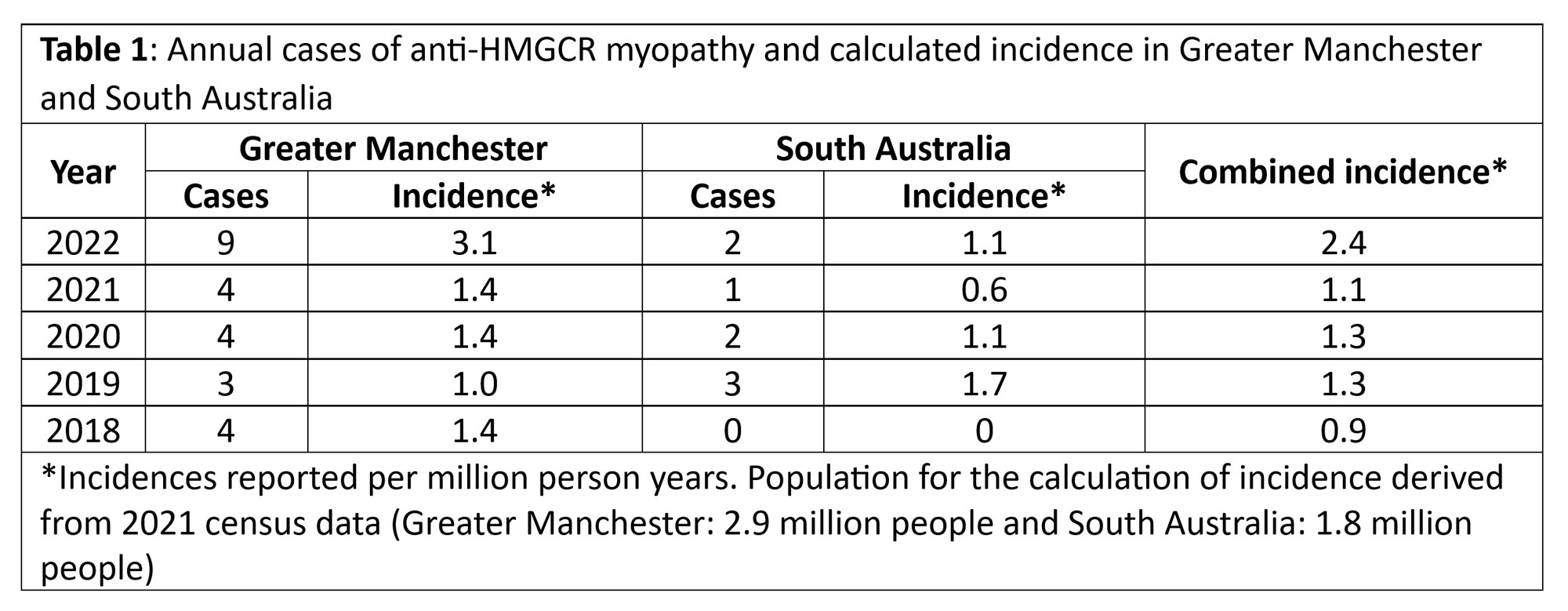Session Information
Date: Monday, November 13, 2023
Title: (1155–1182) Muscle Biology, Myositis & Myopathies – Basic & Clinical Science Poster II
Session Type: Poster Session B
Session Time: 9:00AM-11:00AM
Background/Purpose: Immune-mediated necrotising myopathy (IMNM) is a rare complication of statin therapy, associated with the development of anti-HMGCR antibodies directed against the enzymatic target of statins (3-hydroxy-3-methylglutaryl-CoA). We sought to calculate the incidence of anti-HMGCR IMNM and determine whether there is a malignancy association in two independent cohorts of anti-HMGCR positive patients presenting to specialist rheumatology services in Greater Manchester (GM), United Kingdom, and South Australia (SA), Australia.
Methods: Patients with detected anti-HMGCR antibodies (January 2018-December 2022) were identified. Demographics, statin exposure, details of any previous or current malignancy, date of self-reported symptom onset and peak creatine kinase (CK) level were recorded. Using population data from 2021 by the Office of National Statistics (GM: 2.9 million people) and the Australian Bureau of Statistics (SA: 1.8 million people), annual incidences were calculated.
Results: The combined incidence of anti-HMGCR IMNM in our cohorts was 0.9-2.4 per million person years over the study period (Table 1). There was more than a doubling of incidence in GM from 2021 to 2022 despite stable testing practices (57-68 tests for anti-HMGCR performed annually). Twenty-four patients (50% female, 71% Caucasian, median age 63.6 years, range: 18.5-89.9 years) from GM and eight (37.5% female, 63% Caucasian, median age 70.3 years, range: 57.9-82.2 years) from SA were identified with a median follow-up of 16.3 months (range: 1.03-58.7 months). The time from first self-reported symptom to anti-HMGCR antibody testing was shorter in SA than GM (median 6.8 vs 22.5 months). Three patients (all female, aged 18, 28 and 60 years) were statin-naïve. Most patients (18/29) were exposed to atorvastatin (3/29 to simvastatin, 3/29 to rosuvastatin, 5/29 unknown). The median duration of statin use prior to anti-HMGCR testing was 36 months (range: 1-120 months). Five patients had a history of prior malignancy (hepatocellular, parotid, prostate (2), renal); notably all except one (data unavailable) occurred more than five years prior to anti-HMGCR testing. The median peak CK was 5000U/L (range: 964-39076U/L). Where data was available, CK subsequently normalised in 8/27 (29.6%) (time from treatment to stable normal CK: median 12 months, range: 2.3-69.2 months) and 8/25 (32%) had regained normal muscle power. Where data was available, more than half (10/16, 62.5%) remained on prednisolone at time of latest review (median 8 months after anti-HMGCR testing, median dose 5.5mg daily)
Conclusion: We confirm that anti-HMGCR is a rare subtype of inflammatory myopathy and report a recent apparent increase in the incidence of anti-HMGCR IMNM in the GM cohort. We found no temporal association of anti-HMGCR IMNM with malignancy within the timeframes usually defined for cancer-associated myositis. The difference between GM and SA in time from self-reported symptom onset to anti-HMGCR testing likely reflects varying pathways of specialist referral. Further multi-site collaborations will help to clarify the epidemiology of anti-HMGCR IMNM.
To cite this abstract in AMA style:
Khoo T, Lyu X, Lilleker J, Lamb J, Limaye V, Chinoy H. Anti-HMGCR Immune-mediated Necrotising Myopathy: Calculation of Incidence and Confirmation of Low Malignancy Risk in Two Independent Cohorts. a Retrospective Case Review [abstract]. Arthritis Rheumatol. 2023; 75 (suppl 9). https://acrabstracts.org/abstract/anti-hmgcr-immune-mediated-necrotising-myopathy-calculation-of-incidence-and-confirmation-of-low-malignancy-risk-in-two-independent-cohorts-a-retrospective-case-review/. Accessed .« Back to ACR Convergence 2023
ACR Meeting Abstracts - https://acrabstracts.org/abstract/anti-hmgcr-immune-mediated-necrotising-myopathy-calculation-of-incidence-and-confirmation-of-low-malignancy-risk-in-two-independent-cohorts-a-retrospective-case-review/

